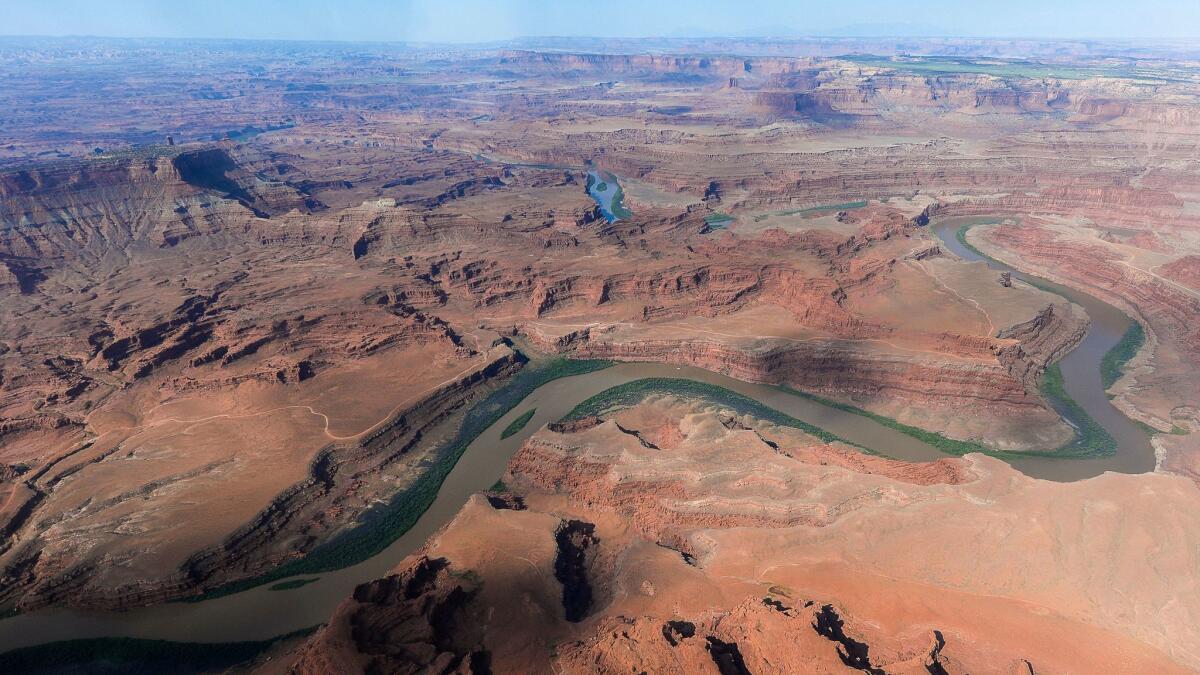Editorial: Leave the national monuments alone

- Share via
More than a century ago, to prevent the degradation of open natural spaces and the pillaging of ruins and prehistoric sites, Congress adopted the Antiquities Act, which gives the president the authority and flexibility to unilaterally protect historically or geologically significant federal lands from exploitation. Four months later, President Roosevelt used the act to establish the Devil’s Tower National Monument in Wyoming, the first of 152 such set-asides. All but three presidents since then have created national monuments under the act to protect federal lands from development, mining or other landscape-altering activities.
Enter President Trump. On Wednesday, he ordered the Interior secretary, who oversees national monuments, to review two decades of designations larger than 100,000 acres (more than two dozen monuments) and, if he decides it’s merited, propose legislation or administrative steps to modify the proclamations. The move dovetails with long-running efforts by some Western politicians to transfer federal lands to the states under the unpersuasive argument that states know best how to manage land within their borders, an argument that Trump seemed to endorse in his public comments when he signed the executive order.
Focusing strictly on the Obama administration, Trump described the designation of monuments as a “massive federal land grab” and an “egregious abuse of federal power” and said his order would “give that power back to the states and the people, where it belongs.” But the monuments were carved out of existing federal land that has been under Washington’s control since the nation’s westward expansion — and which predates the states themselves. And the states have little interest in protecting the land: They want to be able to open it for extractive industries, which fits in with Trump’s desire to dig, drill and burn more fossil fuels with blithe disregard for the environment.
The monuments were carved out of existing federal land that has been under Washington’s control since the nation’s westward expansion.
This is contrary to public interest. No one has offered a convincing argument that there is a problem in need of a solution or that the previously declared monuments were poorly chosen. Historically, in fact, Congress often has converted some presidentially selected monuments into national parks, which receive an even higher level of protection. They include the Grand Canyon and the Grand Tetons and, here in California, Death Valley and Mt. Lassen. The trigger for Trump’s review was President Obama’s designation last year of the Bears Ears National Monument in Utah, a stunningly picturesque region that state political figures wanted to open to oil and gas drillers and potash mining companies. But the Interior Department reviews will stretch back to Grand Staircase-Escalante, also in Utah, designated a national monument by President Clinton.
It’s probably too much to hope that Interior Secretary Ryan Zinke will report back to Trump that none of the monuments should be altered or withdrawn, and that the Antiquities Act is a valuable tool for a president. Fortunately, the president’s authority to undo the designations of his predecessors is in doubt. The Antiquities Act grants the president the authority to designate monuments but says nothing about the right to change, amend or revoke designations (although Congress can do so through legislation). Some presidents have reduced the size of monuments, but those changes went unchallenged in court. Environmental groups have promised a legal fight should Trump seek to alter the designations.
Zinke and Trump both said the review would give the public a chance to weigh in. But it already has. The Bears Ears designation, for instance, came after more than seven years of broad public debate and after a rival land-use plan by Utah’s congressional delegation failed to gain traction.
The Antiquities Act was passed after Americans, following the lead of John Muir and other naturalists, recognized that there was more to the vast expanses of the West than land to be tilled, forests to be felled and ores to be mined. Roosevelt wrote in 1913 that it is “vandalism … to destroy or to permit the destruction of what is beautiful in nature, whether it be a cliff, a forest, or a species of mammal or bird. Here in the United States we turn our rivers and streams into sewers and dumping-grounds, we pollute the air, we destroy forests, and exterminate fishes, birds and mammals — not to speak of vulgarizing charming landscapes with hideous advertisements. But at last it looks as if our people were awakening.”
The people need to remain awake, and they need to fight to ensure that neither the Trump administration nor the fossil fuel-friendly congressional leadership succeeds in this assault on our shared national heritage.
Follow the Opinion section on Twitter @latimesopinion or Facebook
More to Read
A cure for the common opinion
Get thought-provoking perspectives with our weekly newsletter.
You may occasionally receive promotional content from the Los Angeles Times.









